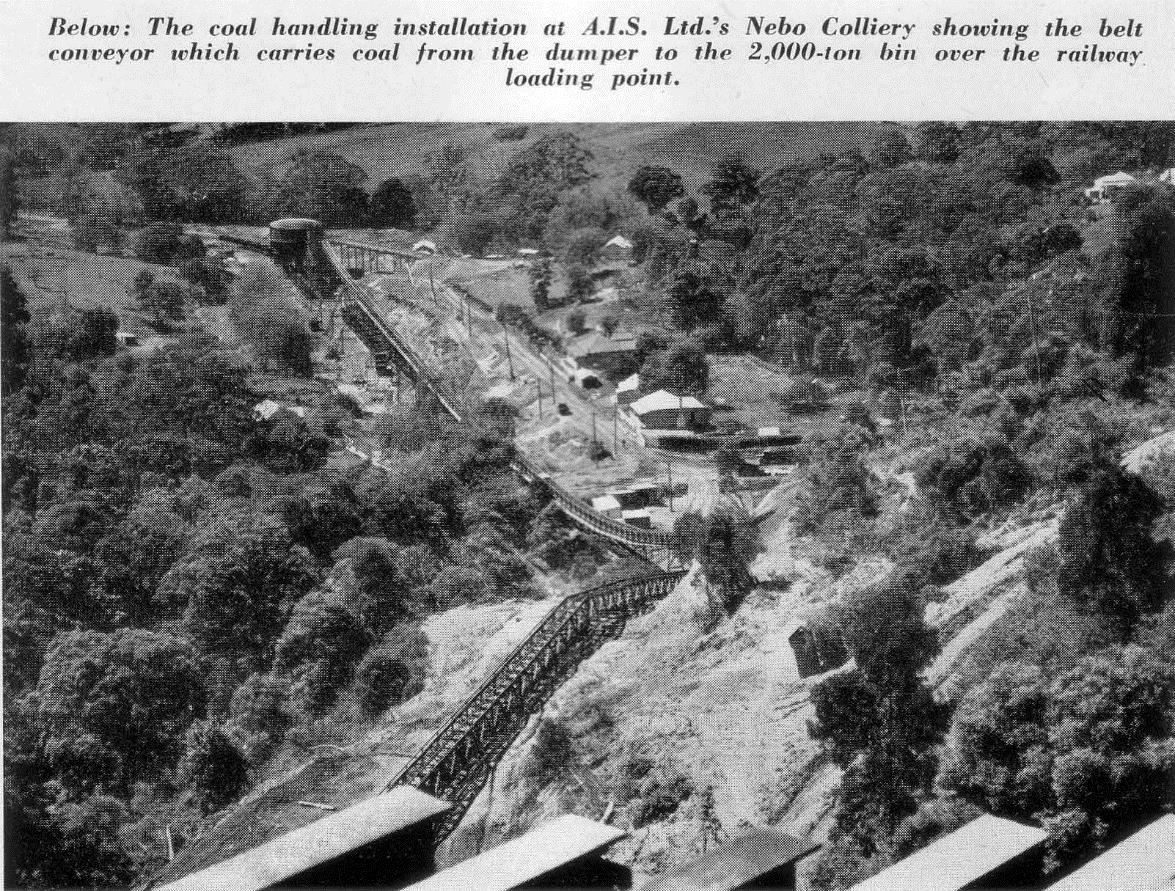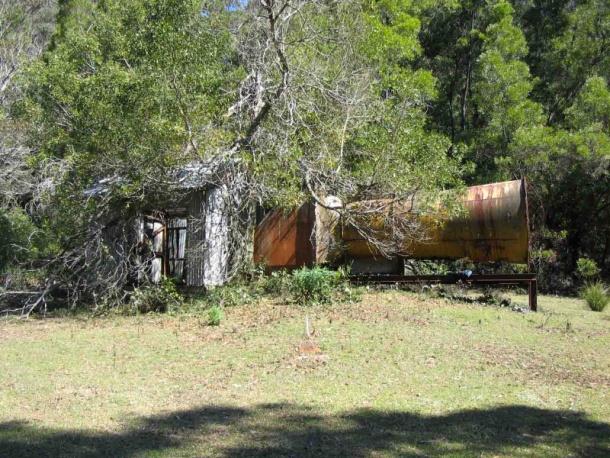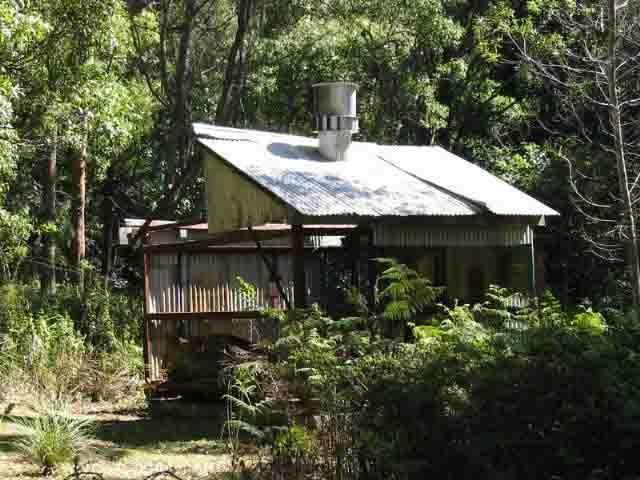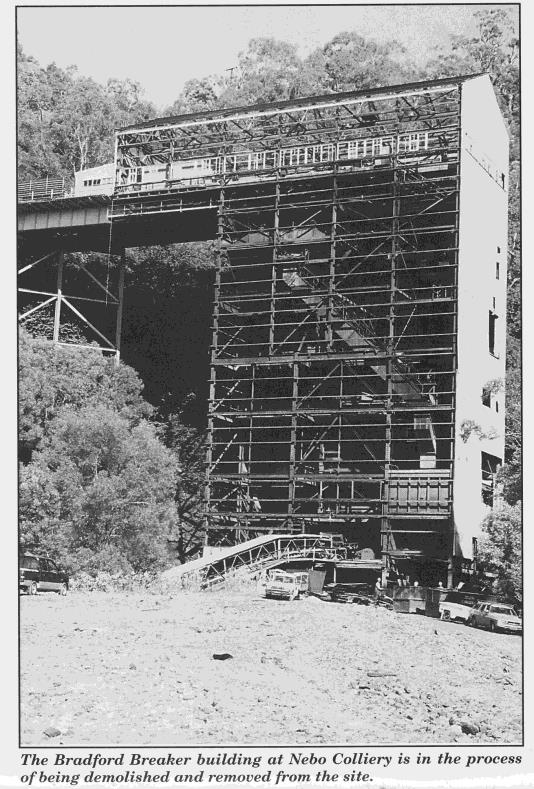Nebo Colliery
(1946 – 1993)
(Rev 3.7)
- Opened: 4/11/1946
- Location: Mt Kembla
- Seam worked: Wongawilli (#3 Seam)
- Owner: AI&S
- Purchased: New Mine
- Closed: Incorporated into Elouera Colliery, 17th Dec 1992
1946 – AIS purchases Mt Kembla mine along with its private rail-line to Port Kembla.
1946 - Operations commenced on the 4th November 1946 in the Wongawilli seam. Mechanised from the outset with track mounted Jeffrey 29C coal cutters and L400 loaders, loading directly into 10 ton mine cars.
1946 – The original ventilation is by a small temporary fan to the north of the original portal being replaced by the “existing” [2001] fan structure. Fan motor house, fan and concrete ventilation drift connected to the main tunnels. (Rogers, B. 2001 Nebo Colliery - an Archival Record)
1946 – Gas discovered for first time, 02/07/1946, from dyke in face of #4 hdg. (DoMAR 1946)
1946 – Inrush of water from dyke in face of main hdg. No damage, 6 working places temporarily rendered idle, pumps installed and water managed. (DoMAR 1946)
1947 – Jan. Production ~200 tons/day (Rogers, B. 2001 Nebo Colliery - an Archival Record)
1949 -

1950 – Fatality, 27th April – Herbert Cockell, rigger, slipped from top of stone chute 100’ to ground (DoMAR 1950)
1950 – Fatality, 1st July – J. L. Moutan, Asst. to Manager, Wongawilli Colliery, crushed between a shuttle car and prop. (DoMAR 1950)
1951 – 05/11/1951 Heavy roof movement over advanced workings extending to 30 acres. Machines withdrawn, large volumes of methane gas liberated. Cause attributed to gas pressures in strata immediately above the coal seam and uneven stresses in overlying old workings. Production resumed 26/11/1951 (DoMAR 1951)
1952 – Oct. Semi trackless mining introduced as Anderson Boyes “Dreadnought” coal cutters and Joy 11BU Loaders.
1952 – Fatality, 24th Sept – P. D. Smith, engineering fitter, struck by delivery end of L400 that was being flitted. (DoMAR1952)
1952 – Fatalities, 18th Dec – James Gordon Grey, crane driver & John James Herrington, rigger, when derrick crane collapsed at the new coal handling plant construction. (DoMAR 1952)
1953 – August, a proposal to connect the Nebo #3 Seam workings with the old Mt Kembla furnace shaft close to Cordeaux Road is floated. (Rogers, B.)
1954 – January, the proposal to connect with the Mt Kembla furnace shaft is abandoned as the old Mt Kembla mine workings are considered to be a contributing factor in the Nebo #3 Seam roof instability problem. (Rogers, B.)
1954 – October, a decision is made to sink 2 x 6 ft. diameter shafts by Calyx drill and fit each with a fan. (Rogers, B.)
1954 – Nebo Calyx Shaft #1 commenced 26-11-1954 & completed 26-4-1955.
Surface to roof of #3 Seam (149.50m). (BHPB Illawarra Coal Geological Records)

Nebo #1 Calyx Shaft – 14/09/2002 (Sheldrill)
1955 - Nebo Calyx Shaft #2 commenced 21-07-1955 & completed 28-10-1955. Surface to roof of #3 Seam (148.819m). (BHPB Illawarra Coal Geological Records)

Nebo #2 Calyx Shaft and fan – 7/09/2005 (Sheldrill)
Both Nebo Calyx Shafts were steel lined and originally equipped with 69” Hi-Flow “K” Series axial flow fans.
1957 - Shuttle cars introduced underground.
1957 – Fatality, 31st July – A. A. Kermond, Shiftman (DoMAR 1957)
1958 – Fatality, 7th May – L. Williams, Mechanical Fitter (DoMAR 1958)
1958 – Sep. Roof bolting introduced (Fletcher bolters) (Rogers, B. 2001 Nebo Colliery - an Archival Record)
1959 – Working No. 3 (Wongawilli) seam with 4 x conventional and 4 x CMs, using roof bolting in addition to steel & timber supports. Heavy conditions worsened towards end of year. Ave. daily production is 1,850 tons hauled to surface by diesel locos. (DoMAR 1959)
1960 – Two-shift production adopted with 4 continuous miners to counteract difficult roof conditions. Inbye roads are still deteriorating. (DoMAR 1960)
1960 – No. 3 Shaft is commenced July 1960, by end of year at the Wongawilli seam, 450 ft. Sinking is undertaken by R. G. Cram & Sons (DoMAR 1960)
1961 – No. 3 Shaft equipped with fans and operates as an u/cast ventilation shaft. Arched roof supports are in use at the face of the main development headings. One heading is approx. 250 yards towards a pre sunk shaft. (DoMAR 1961)
1962 – Work commences on a cross measures drift and staple shaft for u/g coal storage. One of the 2 mine fans installed on the Calyx Shafts Nos. 1 and 2 is shifted to Nebo No. 3 Shaft at end of the year. (DoMAR 1962)
1963 – A short drift and staple shaft are completed. Re-organisation of the haulage system is nearly complete following the installation of 1 ¼ miles of c/v belt in the new development headings. (DoMAR 1963)
1970 – Nebo Calyx shafts Nos. 1 & 2 are decommissioned.
1971 – A new control cabin is commissioned at the surface replacing the original underground cabin. Fast diesel man-cars are introduced.
1974, (23/24/12/74) – No. 3 Shaft fans tested. - ~110,000 cfm each. (orig. install = 250,000 cfm) (From notes retrieved from Nebo Maintenance Conference Minutes)
1976 – Introduction of a shortwall system however adverse geological conditions saw it withdrawn from service after 4 months and 23,180 tons of coal.
1979, Feb. – Memo requesting mine site upgrade:-
1. – Request for 3 more Fox DMCs (total would then be 17)
2. – 180 x 10 ton skips in use. Requisition for separate workshop.
3. – Request to relocate and increase the size of the control cabin.
4. – Only a single 2,000 tonne bin for ROM coal. Should consider a second 2,000 tonne bin.
5. – 5 x Hexham feeders in use. 7 years old, request updated feeders.
1980 – A new shaft (#4) is commenced at Nebo (DoMAR 1980)
1981 – No. 4 shaft at 170m, due for completion end of year. (DoMAR 1981)
1982 – No. 4 shaft completed, used as downcast. (DoMAR 1982)
1982 – No. 4 shaft is equipped with twin 450kW centrifugal 270” WZF series Aerex fans.
1982 – The wastewater and sewage treatment plant is brought into operation.
1984 – November – M/c locations:-
CM63 – Torres Panel
CM76 – Forbes Panel
CM81 – MAC 10
CM93 – MAC 4
CM97 – Howe Panel
(From notes retrieved from Nebo Maintenance Conference Minutes)
1985 – 01/10/85 - Stephen David appointed Deputy Manager, Nebo Colliery (formerly Mining Engineer – Projects, Planning and Mine Services). (BHP documents 30th Sept 1985)
1992 – 17th Dec, Nebo, Wongawilli and Kemira Collieries are integrated as Elouera Colliery. Wongawilli pit top is established as the pit top for Elouera, Nebo portal becomes “second means of egress” for the mine.
1993 – January, Nebo Colliery ceases production, prompting the demolition of the Bradford breaker building and coal bin at Kemira Valley (Coal News, Issue 94, Oct 1993)

2001 – Dendrobium Colliery is established utilising the old Nebo surface infrastructure.
2002 – Initial drives into the outcrop by Dendrobium Colliery.
2006 – Nebo Calyx Shafts Nos. 1 & 2 are backfilled, capped and the site rehabilitated. Nebo No. 3 Shaft is downcasting with Nebo No. 4 Shaft upcasting, now servicing Elouera Colliery.
2007 – Elouera Colliery (in conjunction with Avondale Colliery) is acquired by Gujarat NRE being renamed NRE Wongawilli Colliery.
[(DoMAR) – Department of Mines Annual Report]
